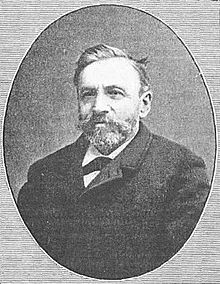You can help expand this article with text translated from the corresponding article in French. (April 2009) Click [show] for important translation instructions.
|
Stanislas Victor Edouard Lépine (October 3, 1835 – September 28, 1892) was a French painter who specialized in landscapes, especially views of the Seine.
Stanislas Lépine | |
|---|---|
 Portrait of Stanislas Lépine by Louis Chrétiennot (1893) | |
| Born | October 3, 1835 |
| Died | September 28, 1892 |
| Nationality | French |
| Known for | Painting |
Biography
editLépine was born in Caen. An important influence in his artistic formation was Corot, whom he met in Normandy in 1859, becoming his student the following year.
Lépine's favorite subject was the Seine, which he was to paint in all its aspects for the rest of his life. He is considered a harbinger of the future, heralding the evolution of traditional plein-air landscape painting into Impressionism and modern art. Lépine was part of a movement of artists who painted outside, developing a new visual vocabulary that captured the changeability of nature, an “impression” of a landscape replacing a literal reproduction of it.[1] He participated in the First Impressionist Exhibition, held at Nadar's in 1874,[2] although he is generally not considered an Impressionist. His paintings are placid in mood and are usually small in scale. Lépine was awarded a gold medal at the Exposition Universelle of 1889 for his painting Pont de l'Estacade.[3] He died suddenly in Paris in 1892.
Gallery
edit-
Stanislas Lépine, The Pont de l'Estacade, Paris, c. 1880 – c. 1884
-
Stanislas Lépine, Pont de la Tournelle, Paris, 1862
References
edit- ^ Newhouse, Jill. "Stanislas Lépine". Jill Newhouse Gallery.
- ^ Rewald, John (1973). The History of Impressionism (Fourth ed.). New York: Museum of Modern Art. pp. 313–316, 591. ISBN 0-87070-360-6.
{{cite book}}: CS1 maint: ignored ISBN errors (link) - ^ Courthion, Pierre (1972). Impressionism. New York: Haryy N Abrams, Inc. p. 96. ISBN 978-0-8109-0202-2. SBN 8109-0202-8.
External links
edit- Media related to Stanislas Lépine at Wikimedia Commons
- Stanislas Lépine – Rehs Galleries' biography on the artist and an image of his painting Navires au Porte (c. 1860–1865).
- Stanislas Lépine Artist biography from Jill Newhouse Gallery, New York